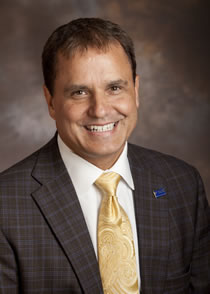
Todd Sherer, director of the Office of Technology Transfer
Todd Sherer, director of the Office of Technology Transfer (OTT), sometimes describes his office as a dating service, matching Emory scientists and their discoveries with the industry personnel who can get these discoveries to market.
Over the past two decades, such matches have resulted in more than $788 million in licensing revenue from drugs, diagnostics, devices, and consumer products. This income subsidizes research and education, including new initiatives, buildings, and—particularly enticing to researchers — unrestricted funds for labs or projects involved in the discovery. The researchers themselves also get a share.
The impact on humanity is even greater. Take, for example, the Emory Cardiac Toolbox, software developed by Emory nuclear medicine expert Ernest Garcia, which helped revolutionize diagnosis of heart disease by enabling clinicians to better interpret images from cardiac imaging technology. This still-evolving collection of software is used in 4 million heart imaging tests a year. Or consider one of the largest academic licensing and royalty deals in history: the development and commercialization of HIV/AIDS drugs discovered by Ray Schinazi and Dennis Liotta. More than 90 percent of Americans and Europeans on antiretroviral therapy for HIV, and thousands more around the world, take at least one of these drugs, estimated to have saved more than 3 million lives.
There are currently 27 licensed therapeutic products in the marketplace based on Emory discoveries and another 12 in various stages of development.
How the process works
Getting players ready— First, Sherer's team connects with Emory researchers whose work might have commercial potential. Next, the team persuades the researcher to disclose enough information so office interns, many of them postdocs, can scour the scientific and patent literature to see what already is available. If the discovery still looks promising, the OTT attorney applies for patent protection.
Seeking out suitors— Patented discoveries then are marketed on the OTT website, in various technology listings on the web, or directly to companies whose research and development programs overlap with the discovery.
Negotiating the deal— What Sherer and his team are selling is not the discovery itself but rather a license to do the necessary research and development to move it to market. Emory may have to invest as much as $100,000 in patent protection alone as part of the process of getting a discovery to this point; a big pharmaceutical company may then spend $800 million to get a new drug developed, tested, and approved or tens of millions to get a new medical device in production.
Creating a start-up— Sometimes no interested corporate partner can be found, so Emory decides to create a company itself. Thus far, Emory has spun off 51 such start-ups.
Changing times— The Emory OTT was established in the mid-1980s, shortly after the Bayh-Dole Act allowed universities to take ownership of their own inventions. A little slow out of the starting gate, Emory has more than made up for lost time. Since Sherer arrived in 2003, his office's budget has grown to $3.5 million, the staff from eight to 20 (mostly case managers and licensing associates), and the track record to roughly 40 successful agreements per year. Sherer himself is currently president-elect of the Association of University Technology Managers.
Meanwhile, scientific achievement has burgeoned. In a recent article in New England Journal of Medicine, Emory ranked fourth among federally funded research institutions for discovery of new pharmaceuticals and vaccines, bested only by big hitters such as National Institute of Health, the University of California system and Memorial Sloan-Kettering Hospitals.
The mindset of researchers everywhere also has changed. When Sherer first entered the field 20 years ago, department chairs considered tech transfer at best a distraction from the real work of publications and grants, at worse tainted money. Today scientists and administrators recognize their obligation to get work to the public as quickly as possible — and the potential for economic benefit (slim, infrequent, but nonetheless real). Whereas Sherer once spent time assuaging doubts, he now spends more time managing expectations, including why Emory cannot patent and market all of the many good discoveries made here. It's a good problem for a matchmaker.
